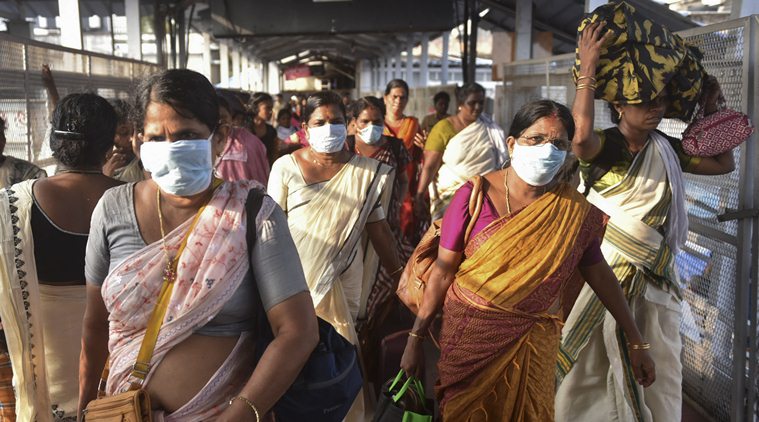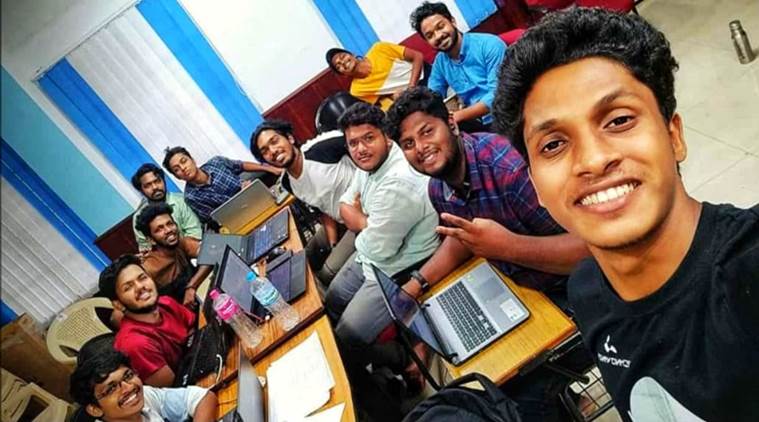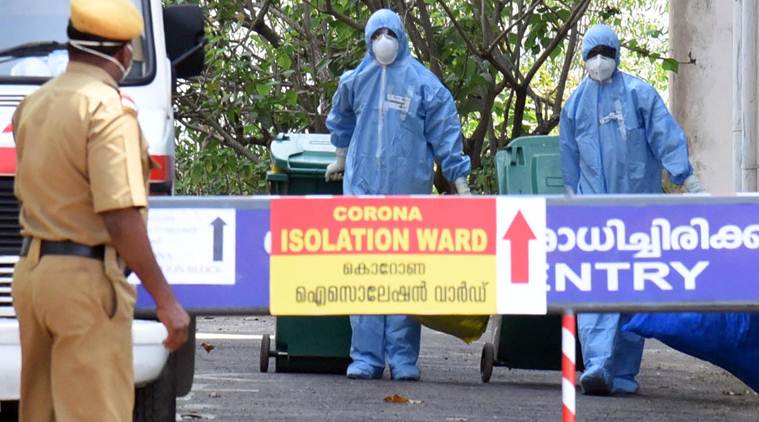 In Kerala, 17 people have tested positive for the novel coronavirus. (AP Photo/File)
In Kerala, 17 people have tested positive for the novel coronavirus. (AP Photo/File)
GPS tracking of quarantine locations, putting together spatio-temporal flow maps of route movements, assessing CCTV footage, call records and employing dedicated neighbourhood watch staff are some of the many ways in which a district administration and Kerala’s health department tracked down over 900 primary and secondary contacts of a family who returned from Italy carrying the Covid-19 infection.
The authorities in Pathanamthitta, a district in central Kerala, in close conjunction with the state’s health department knew they were up for a formidable task when they realised that a couple and their 25-year-old son hailing from Ranni, after their arrival from Italy on Feb 29, may have accidentally dispersed the infection into the community by traveling extensively in the region and meeting many of their relatives. The government has alleged that the family willfully hid their travel history and did not report for mandatory checks at the local hospital. The three-member family and four of their relatives are currently being treated in hospital isolation wards after testing positive for Covid-19.
17 different teams and creating spatio-temporal flow maps
The challenge before the health officials was putting together a flow chart, based on spatio-temporal mapping, of all the places that the family traveled to and the potential contacts they would have made there, between Feb 29 and March 6. Separate medical teams were deputed to carry out field visits and glean information from the infected family. Based on the collected information, top officials got to work, charting a linear narrative of the family’s movements in the region. Some of these places included restaurants, banks, post offices and churches near Ranni and Punalur.
A doctor who was part of the surveillance meetings said, 17 medical teams were deputed on the field to visit these places, identify contacts based on their interactions with the family and place them under home quarantine. Each team consisted of two community medicine doctors, a doctor from the state health services and a field staff. The field staff could be a junior health inspector or a junior public health nurse.
“It was extremely challenging. Our field teams had to go and verify the CCTV footage in many of the places. All of our 17 teams have worked very hard to track the movements of the patients. Those who had direct contact with the family were classified as primary contacts. And those who interacted with the primary contacts were classified as secondary contacts. The primary contacts are the high-risk cases,” said the doctor.
Since a lot of the places the family visited were facilities such as banks and restaurants, the officials decided to release the flow charts to the public to get more information. The flow charts were published on social media platforms along with helpline numbers on which people could notify if they were present at any of those places. In case of discrepancies, the flow charts were accordingly updated.
The district collector on Tuesday wrote on his official Facebook page, “We got 70 calls yesterday based on the flow-charts we released as part of coronavirus surveillance. Out of these, 15 people were under primary contact list and 14 of them had been quarantined at home. One person who was not in the list was identified and since he exhibited symptoms, he was admitted to hospital.”
As of March 11, 892 people are under observation in Pathanamthitta, out of which 860 people are under home quarantine and the remaining isolated in hospitals. Almost all of them have had primary or secondary contact with the family of three from Ranni.
GPS tracking of those under home quarantine
Drawing from experiences learnt during the 2018 floods, the district administration has called upon a team of student volunteers to set up GPS tracking of those under quarantine. A team of 15 engineering students are currently working at the Collectorate office in Pathanamthitta using basic geo-mapping tools to plot the addresses of those under observation in homes.
“The advantage is that we can identify the clusters and the high-risk neighbourhoods based on the maps. This can help us strengthen the contact list,” said a doctor familiar with the exercise.
 A team of 15 engineering students is currently working at the Collectorate office in Pathanamthitta using basic geo-mapping tools to plot the addresses of those under observation in homes. (Source: Facebook/ Pathanamthitta Collectorate)
A team of 15 engineering students is currently working at the Collectorate office in Pathanamthitta using basic geo-mapping tools to plot the addresses of those under observation in homes. (Source: Facebook/ Pathanamthitta Collectorate)
All the primary contacts and their addresses have already been plotted on maps while the process of plotting the secondary contacts will be completed by Thursday evening (March 12).The plan was put into motion to ensure that those under quarantine adhere to the protocol and do not step out of their homes. Health officials were alarmed earlier this week when a suspected patient escaped for a few hours from an isolation ward at a hospital. Frantic efforts by health officials and the local police ensured he was found and brought back into isolation. The government has warned of legal action against those violating home quarantine rules.
“Many of these people under home quarantine have non-medical needs like buying groceries or things for the household. So every day by 4 pm, we assess the non-medical needs of these people under quarantine and pass on the information to the local panchayat. By next day, panchayat officials supply them to the households. We are also providing food to the most vulnerable sections of the society,” said the doctor.
The GPS locations of those under quarantine are also given to ambulance services. If a person is found to be symptomatic, he/she is transferred immediately to the hospital in the designated ambulances.
Community surveillance system in place
An intricate surveillance net has been cast to ensure compliance with home quarantine measures. This includes daily monitoring of the contacts over the phone as well as keeping a watch on them physically through a neighbourhood watch. As per latest data, home quarantine compliance stands at 85%.
A medical officer said, calls are made twice a day to the households from the district control room, as well as once in the evening from the local primary health centre. Every quarantined member will have a designated field staff. Calls are made for psychological support as well as for enquiring about non-medical needs.
 A medical officer said, calls are made twice a day to the households from the district control room, as well as once in the evening from the local primary health centre. (Representational Image)
A medical officer said, calls are made twice a day to the households from the district control room, as well as once in the evening from the local primary health centre. (Representational Image)
“We also have a questionnaire filled with 20 questions which we use to indirectly check if they are breaking home quarantine. High-risk contacts can be reported directly to the field staff and they can make physical verification,” said the officer.
“Through a community surveillance system, we have also identified people from within the community like neighbours and ASHA workers. These people are monitoring. They can even be panchayat members. They have different responsibilities on the basis of their social standing and where their homes are located. From such sources also, we are getting information.”
According to the officer, the contact tracing exercise of the health department is in its last phase and the gaps will be plugged by the end of this week.